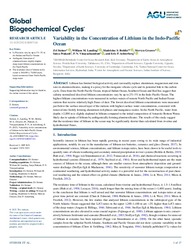Variability in the Concentration of Lithium in the Indo‐Pacific Ocean
Prakash, Satya
DOI: https://doi.org/10.1029/2021GB007184
Persistent URL: http://resolver.sub.uni-goettingen.de/purl?gldocs-11858/10238
Persistent URL: http://resolver.sub.uni-goettingen.de/purl?gldocs-11858/10238
Supplement: https://doi.pangaea.de/10.1594/PANGAEA.941888
Steiner, Zvi; Landing, William M.; Bohlin, Madeleine S.; Greaves, Mervyn; Prakash, Satya; Vinayachandran, P. N.; Achterberg, Eric P., 2022: Variability in the Concentration of Lithium in the Indo‐Pacific Ocean. In: Global Biogeochemical Cycles, Band 36, 6, DOI: 10.1029/2021GB007184.
 |
Dokument öffnen: |
Lithium has limited biological activity and can readily replace aluminium, magnesium and iron ions in aluminosilicates, making it a proxy for the inorganic silicate cycle and its potential link to the carbon cycle. Data from the North Pacific Ocean, tropical Indian Ocean, Southern Ocean and Red Sea suggest that salinity normalized dissolved lithium concentrations vary by up to 2%–3% in the Indo‐Pacific Ocean. The highest lithium concentrations were measured in surface waters of remote North Pacific and Indian Ocean stations that receive relatively high fluxes of dust. The lowest dissolved lithium concentrations were measured just below the surface mixed layer of the stations with highest surface water concentrations, consistent with removal into freshly forming aluminium rich phases and manganese oxides. In the North Pacific, water from depths >2,000 m is slightly depleted in lithium compared to the initial composition of Antarctic Bottom Water, likely due to uptake of lithium by authigenically forming aluminosilicates. The results of this study suggest that the residence time of lithium in the ocean may be significantly shorter than calculated from riverine and hydrothermal fluxes. Key Points:
Li/Na ratios vary by up to 2%–3% in the Indian and Pacific Oceans.
Authigenic formation of aluminosilicates slightly deplete deep‐water lithium concentrations in the North Pacific.
The residence time of lithium in the ocean is 240,000 ± 70,000 years, based on removal from North Pacific deep‐water.
Statistik:
ZugriffsstatistikSammlung:
This is an open access article under the terms of the Creative Commons Attribution License, which permits use, distribution and reproduction in any medium, provided the original work is properly cited.

